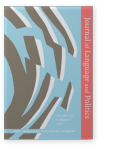Vol. 20:6 (2021) ► pp.894–912
The struggle between the power of language and the language of power
Pro- and anti-vaccination memes and the discursive construction of knowledge
In this study we look at how pro- and anti-vaccination groups construct alternative knowledge and facts discursively and linguistically in order to challenge or support the established scientific knowledge on vaccines. Through this case study we wish to examine how the power of language interacts with a language of power when memes in creative ways mimic, produce and reproduce scientific language and practices. Drawing on a dialogical-semiotic and a discourse theoretical analytical strategy, we, first, adopt Austin’s speech act theory and Bakhtin’s concept of speech genres to argue that memes are performative with an especially illocutionary force and are made up of alien language from scientific discourses. Second, we argue that Laclau’s discursive approach to how political positions are articulated in an antagonistic terrain allows us to see vaccination memes as either subversive or supportive of a scientific social imaginary.
Article outline
- 1.Introduction
- 2.Discursive contestations of knowledge and facts in digital public spheres
- 2.1Speech act, speech genres and truth
- 2.2Contested discourse on knowledge
- 3.Methodology: Memes as text and discourse
- 3.1Data
- 4.Analysing memes as speech act, speech genre and the alien language
- 5.Analysing memes as antagonistic discourse
- 6.Conclusion: The power of language and the language of power
- Notes
-
References
